
Most likely, every child at some point attempted to comprehend constellations and commit their names to memory. My fascination with the stars began after watching an old Soviet cartoon about the Minotaur. Towards the end, Dionysus abducts Ariadne, and they present an image of the sky featuring the corresponding constellations. However, despite my best efforts, I was unable to identify any resemblances to the original names. 🙂
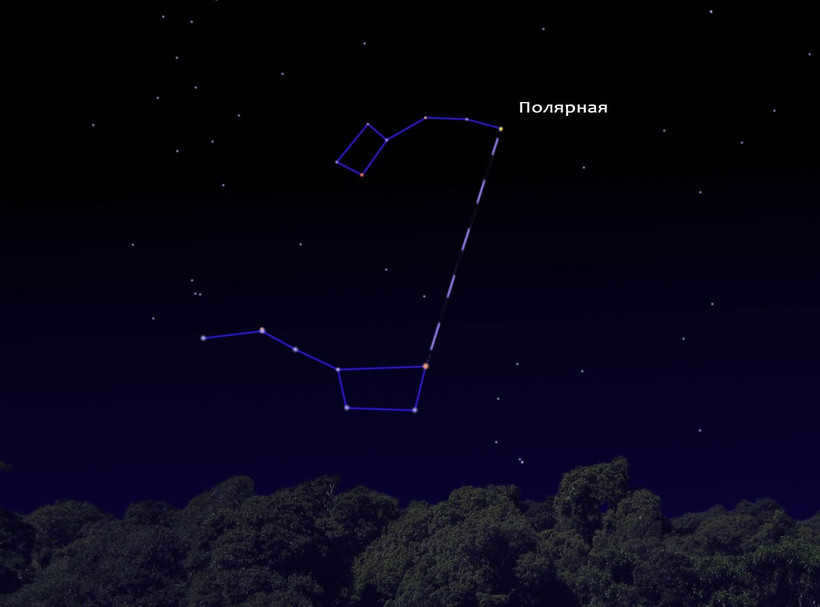
How to locate the North Star in the night sky
I had a similar experience with finding the North Star. I was unsure of where Ursa Major was in the sky and how it related to the Big Dipper. Thankfully, my father took the time to explain it to me. It turns out that all you need to do is locate the Big Dipper, which consists of seven stars, in the night sky. Then, you can trace a straight line from the right edge of the Dipper. This line should be five times longer than the edge itself. It will lead you to another smaller dipper, and it ends right at the tip of its "tail". This final star in the tail is known as the North Star, or Polaris.
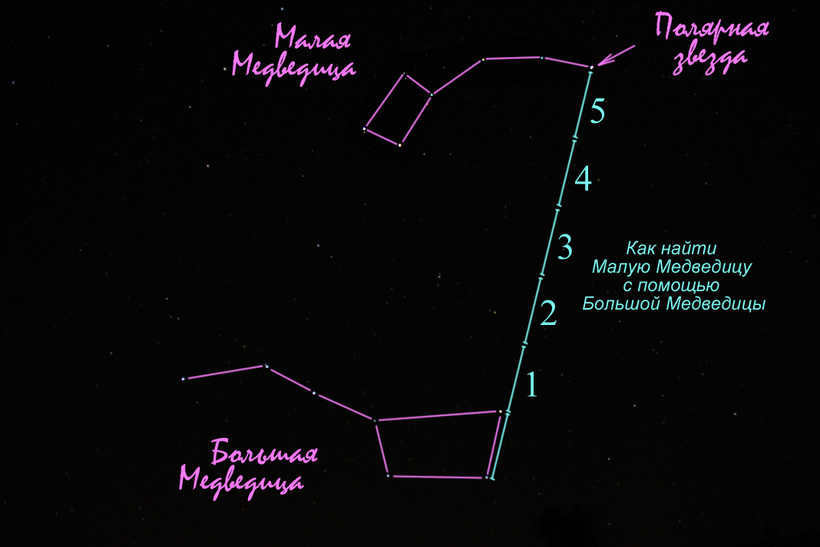
The Southern Cross constellation
However, in the Southern Hemisphere, children do not learn how to locate Polaris. Instead, they memorize the position of the Southern Cross constellation. To accomplish this, first locate the Milky Way and then identify a dark, blot-like spot on it. To the right of this spot, you will see four stars that form a cross. The longer “crossbar” of the cross points towards the south, while the top points towards the north. The directions of west and east are also relatively straightforward.
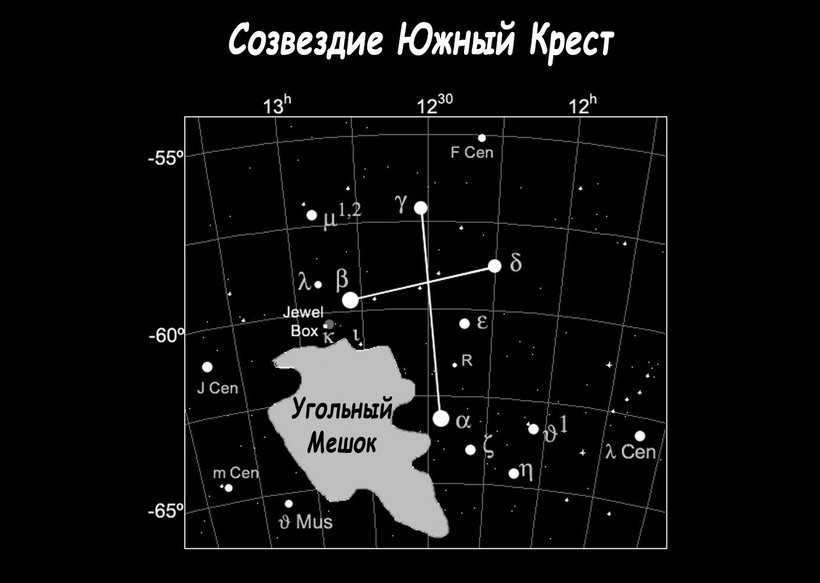
Discovering the Secrets of Polaris
Allow me to share some intriguing tidbits about Polaris that are known by only a select few:

- The claim that Polaris is the most luminous star in the sky is incorrect, as it holds this title only within its constellation;
- In ancient Greece, it was referred to as the “dog’s tail”;
- Its current name is attributed to Peter the Great;
- On ancient celestial maps, the depiction of the Little Bear constellation has a distinct appearance, featuring Polaris as the apex of an unusually long tail of a wandering bear.
According to ancient legends, the constellations of the Big and Little Bears are known as Helica (“bright”) and Kinosura (“canine appendage”) respectively. These constellations were said to have been raised to the heavens for nursing the young Zeus.
I am of the belief that the celestial sky is the most wondrous phenomenon in existence. True, science has long understood the nature and approximate locations of stars. However, whenever I gaze upon the starry sky in the month of August, I am overcome with a sense of awe. Why August, you ask? During this time, the night sky becomes adorned with an abundance of stars, allowing for the observation of nearly all the constellations of the northern hemisphere. It is truly astounding!
But how does one go about locating Polaris amidst the multitude of stars?

Essential details
Personally, my knowledge of how to locate Polaris primarily comes from movies. 🙂 Often, they depict scenarios where sailors find themselves in the vast ocean and must determine their direction. The key to finding their way is the North Star, which always points north.
To locate this star, you must understand a few fundamental facts. Polaris is always directly above the North Pole, so if you were to look up at the night sky from there, you would see it directly above you. Now, let’s think logically – as you move further away from the pole, Polaris will gradually descend closer to the horizon line. When you reach the equator, it will vanish beyond the horizon. Therefore, Polaris serves as a reliable reference only in the Northern Hemisphere.
Contrary to popular belief, Polaris is not the brightest star in the sky. In fact, it doesn’t even rank in the top 10 brightest stars.
Locating Polaris
Here is a practical guide on how to find Polaris:
- Firstly, you can locate Polaris by identifying the constellation it belongs to. Polaris is part of the Small Bucket constellation and can be found at the beginning of its “handle,” as shown in the image below. To find the Small Bucket, first locate the Big Bucket in the night sky, which is relatively easy. Then, using the star Dubhe as a reference point, search for Polaris. The image provides a visual guide. 🙂

- Furthermore, the constellation Cassiopeia can be initially located. I find this approach to be more straightforward. The letter W immediately catches your attention. Then, mentally trace a line as depicted in the illustration. Ultimately, this line should intersect with the Big Dipper, thereby confirming your accurate identification of Polaris.
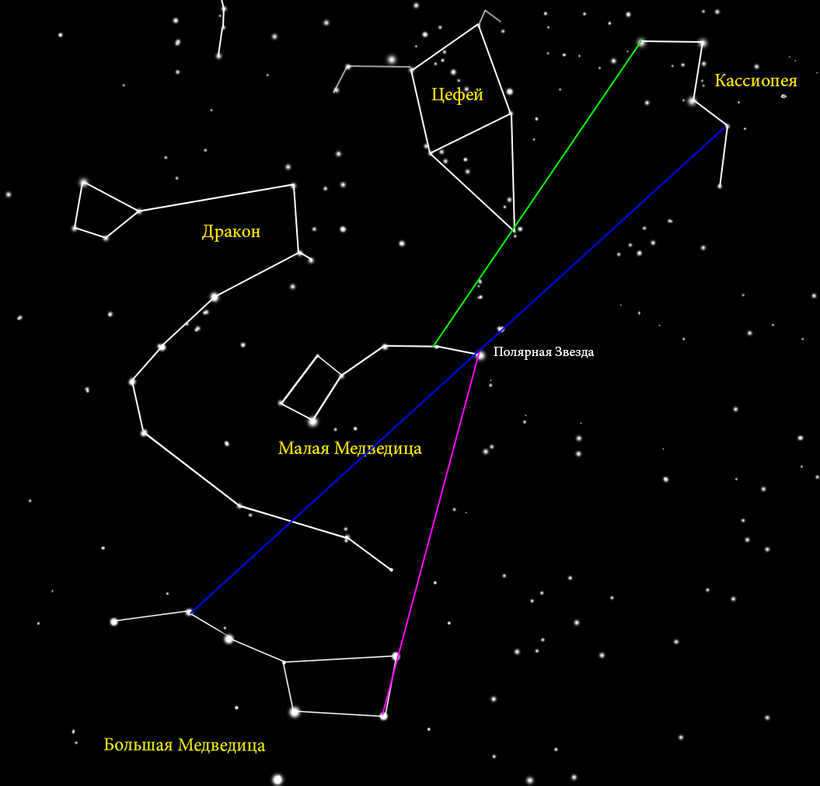
- Additionally, there are specialized smartphone applications available that can provide you with the necessary information using your device’s camera. 🙂
During my time in school, my fascination with astronomy led me to be well-informed about the whereabouts of Polaris. However, it came as a surprise to me that my friends were completely clueless about this celestial entity and its location. In fact, they mistakenly identify the brightest star in the night sky as the elusive “beauty” they believe Polaris to be.

The Remarkable Qualities of Polaris
Many of my acquaintances often mistake Polaris for being the brightest star in the night sky, excluding the Moon. However, this is far from the truth. In reality, Polaris is rather difficult to observe with the naked eye. This inconspicuous star, however, is known for its other intriguing characteristics. During my initial astronomy lessons, my teacher posed the question, “What is the polar star renowned for?”. The answer was quite apparent. Polaris is unique in that it is situated directly on the North Pole, deviating only by a mere 1°. This positioning is what gives it the illusion of being completely motionless to us.
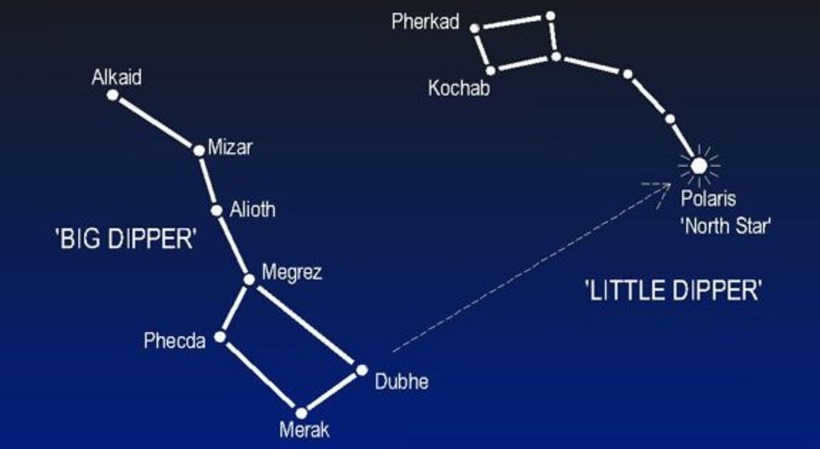
Locating and Identifying Polaris
Although Polaris may not be the most luminous star in the celestial sphere, it can be located with relative ease. During my astronomy lectures, I acquired a handful of useful techniques that I am eager to impart to you:

- If you want to locate the Polar Star, it’s quite simple. Just look for its constellation, which is the Little Bear;
- However, finding the Little Bear itself can be a bit challenging as its stars are not very bright. In that case, you can look for it through the Big Dipper constellation;
- Locate the Big Dipper and focus on its wide part, where two bright stars are situated;
- Draw an imaginary line between these two stars, starting from the less bright one and moving towards the brighter one. Then, extend this line by five segments, each segment being the same length as the distance between the two stars in the Big Dipper;
- After performing these simple steps, you will definitely find the “tail” of the Little Bear, which is also known as the Polar Star.
There are certainly alternative techniques and approaches to locating Polaris, but this particular method proves to be the most user-friendly and straightforward. I have already set it up to activate automatically whenever I gaze at the nighttime sky.
Ever since my school days, I have been captivated by the field of astronomy, and this fascination continues to this day. I derive immense pleasure from observing the celestial expanse and identifying various constellations and stars. And when it comes to locating Polaris, it is a task that I find to be quite effortless.

Where Can You Find Polaris?
Locating Polaris in the night sky is a simple task. Unlike other stars that seem to move across the sky throughout the day and year, Polaris remains in a fixed position. Also known as Polaris, this star is referred to as Kinosura, which means “the tail of the dog” in Russian. It serves as a guide to the North Pole, as it is located only 1° away from it, giving the appearance of being stationary. Polaris is part of the constellation known as the Little Bear and can be found at the tip of the Little Dipper (α, or alpha, of the Little Bear).
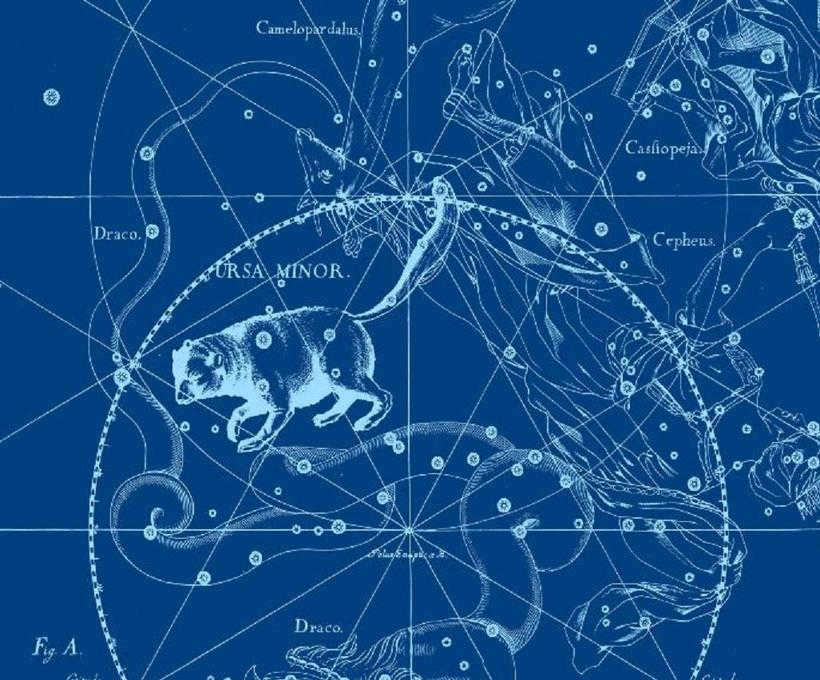
Polaris, which is the nearest and brightest pulsating variable star to our planet, is a cepheid star. Despite being approximately 434 light-years away from Earth (or, according to alternative data, 99 parsecs less, only 111 years), it pulsates by periodically altering its luminosity. How fascinating! Remarkably, this star is not just a single entity, but rather a complex triple star system.
To locate Polaris in the night sky (since it is not the most luminous star, it may not be immediately visible), it is more convenient to initially locate the ladle of the Ursa Major constellation (which is quite prominent and well-known). Next, mentally rotate the ladle five times, as if turning it by its handle and raising it. Eventually, you will locate Polaris on the outer edge of the ladle’s handle. Polaris.
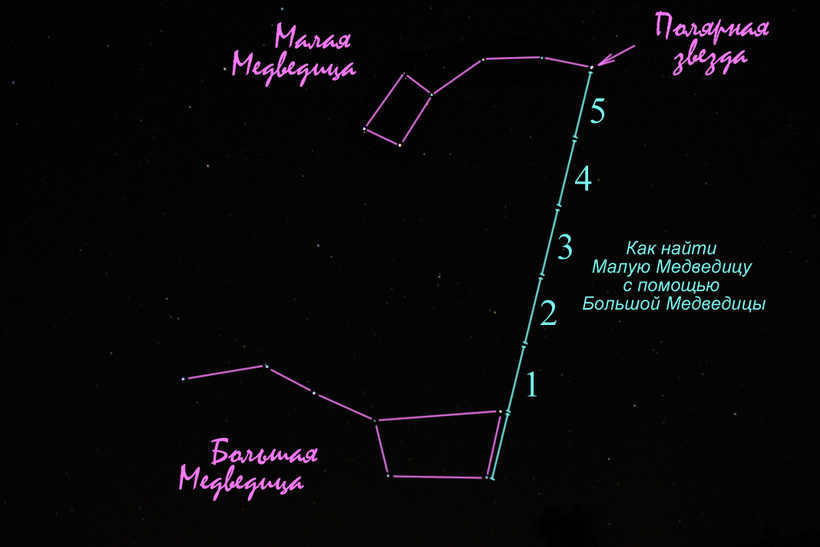
Uncovering the Fascinating Aspects of Polaris
Astronomy is a timeless field of study, with the stars captivating mankind since ancient times, inspiring countless myths and legends. And within this vast realm of celestial wonders, Polaris holds its own unique allure and enigmatic qualities:

- In the past, the North Star did not always indicate the north pole due to the rotation of celestial bodies, and in 2,000 years, it will be replaced by another star;
- Polaris can serve as a reliable navigation tool for any terrain as it consistently points north;
- The star has various names and nicknames, all related to its immobility or its orientation towards the north;
- Polaris is 5,000 times brighter than the sun and 70 times larger in size. Additionally, it is traveling towards the Sun at a speed of 17 kilometers per second;
- The brightness amplitude of the star has been undergoing changes. Previously, it was believed that the star might eventually stabilize, but Polaris remains pulsating and its brightness has actually intensified.
Make sure to search for this celestial body in the heavens, just in case it proves useful.

Approximately three years ago, on a warm summer night, I found myself in the open air. Suddenly, my attention was drawn to a particular group of stars, forming an intriguing shape. It immediately occurred to me that this must be a unique constellation. The following morning, I eagerly searched for this celestial formation on a detailed starry sky map. To my delight, I easily located the constellation. This experience reignited the passion for astronomy that had captured my imagination during my childhood. I now possess a thorough understanding of the whereabouts of Polaris and I am excited to share this knowledge with others.

What is the reason for searching
Polaris is currently the brightest star in the constellation Ursa Minor (I will explain its significance below). It is also known as the Alpha Star of Ursa Minor. Polaris is referred to as the “north star” because it consistently points towards the North Pole of the Earth, regardless of the time of year. This is unlike other celestial bodies, which change their positions in the sky on a daily basis. When observing the night sky, it appears as if the entire sky is rotating around Polaris, as if it is anchored in place. Therefore, Polaris serves as an excellent navigational reference point. However, it is important to note that Polaris has not always been and will not always be the north star of Ursa Minor. Due to the constant movement of celestial objects in the Universe, another star will assume this role in the future, possibly in a millennium from now.
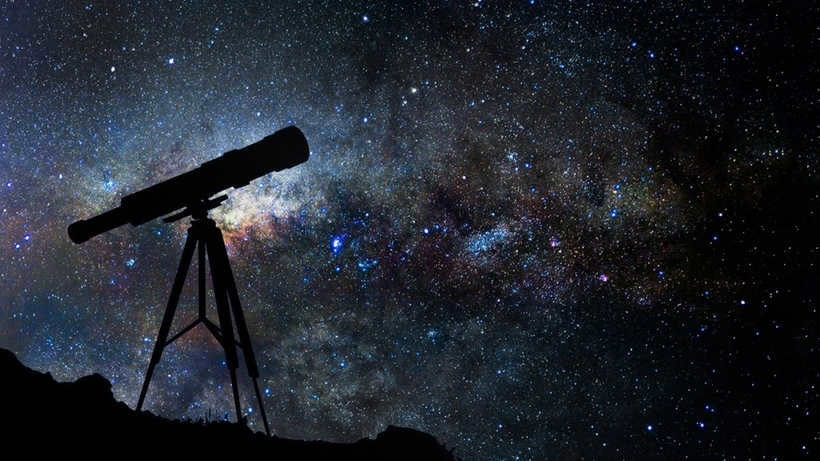
Locating Polaris
Polaris can be easily seen in the northern hemisphere throughout the year. Additionally, it emits a fairly strong light. These factors make it effortless to find Polaris. Depending on your latitude, it will appear at different heights, but in general, in Russia, you can expect to see it at the zenith of the sky. To locate it, you first need to locate the Big Dipper (also known as the Plough). Interestingly, almost every time the night sky is clear enough, I immediately spot this prominent group of six stars. The next step is a simple procedure:
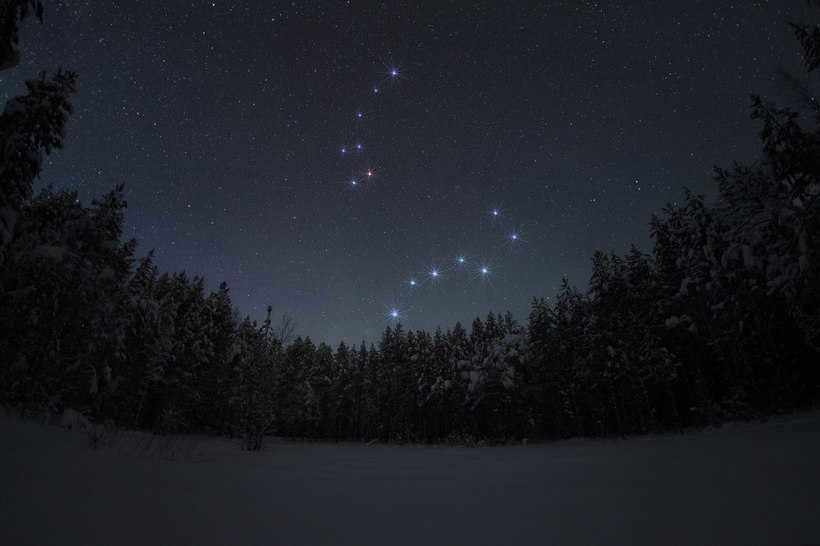
- Visualize an imaginary straight line connecting the two stars – the bottom of the ladle opposite the handle;
- Extend this imaginary line upwards from the constellation;
- Measure on this line from the Big Dipper about five equal segments of the ladle’s base;
- Voila! You have successfully arrived at Polaris.
Hopefully, my response has sparked some curiosity about the celestial realm and will also assist you in finding your way in this domain.

Many of us have been taught about geography and astronomy during our time in school. However, not all of us may remember how to locate the polar star or navigate using starlight. In this aspect, individuals residing in the northern hemisphere are certainly fortunate as they can easily determine the north without the need for a compass or any distinctive landmarks. Many astronomers utilize this clever method for precise orientation on land by relying on the northern luminary. Additionally, its elevation above the horizon is equivalent to the geographic latitude. So, how can one identify this beneficial bright celestial body among the countless constellations in the sky?
Guide to locating the North Star
Locating the polar star is a relatively simple task that most people can easily accomplish.
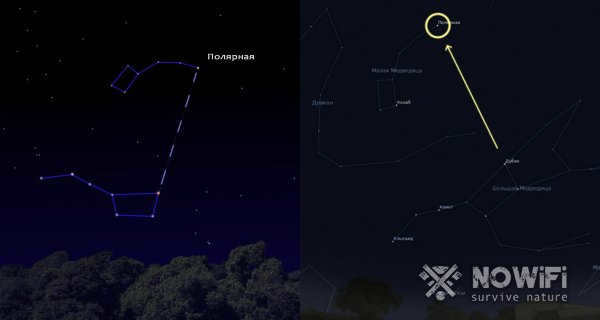
An easy way to locate the polar star is as follows:
- If you have good eyesight and a clear, cloudless sky at night;
- Simply observe the constellations that are visible and utilize some basic knowledge;
- Identify the brightest points in the sky that remain stationary in relation to each other;
- The polar star is located at the end of one of the constellations, specifically the tail of Ursa Major (Figure 1);
- This is the most visible part of the polar star, so it is impossible to mistake it.
The next method, which explains how to find the north polar star, is useful when you don’t have a compass but have access to a large-scale map.
Method number two (Figure 2):
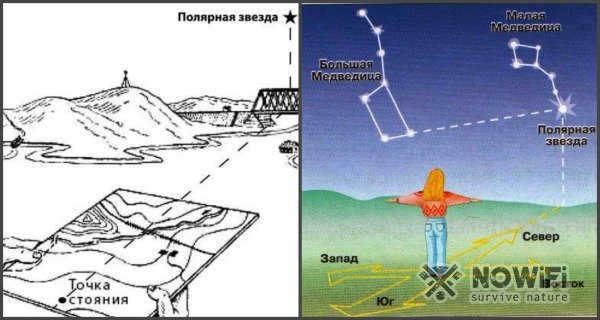
- You can use a regular city map, available for purchase at specialty stores or newsstands;
- Make sure the map has a scale and does not contain any advertising or additional schemes;
- Stand on a linear landmark, such as a road, and locate it on the map;
- Rotate the map to align it with the direction of your chosen position on the ground;
- Confirm that your reference point is correctly positioned and not rotated 180 degrees;
- For instance, if a park, water body, or apartment building is to the right of a linear landmark on the map, it should also be to your right in reality;
- The map will be oriented so that the top part will indicate the direction of your search;
- For increased precision, similar to using a compass, the latitude of the area is identified and the altitude of the object’s position above the horizon is determined.
In order to determine the exact location of the polar star, several factors must be taken into consideration:
- The polar star is only visible in the northern hemisphere.
- In the southern hemisphere, the polar star can only be seen under favorable weather conditions due to light refraction.
- To observe the polar star, one must be positioned at an elevated location.
- The polar star is located no more than 85km from the equator.
- At the equator, where the latitude is zero, the polar star will appear at its lowest point, almost touching the horizon.
- As one moves north, the altitude of the polar star will increase and reach its peak at a latitude of 90 degrees.
Debunking Misconceptions about the North Star
Countless myths and legends have emerged throughout history regarding the enigmatic polar star. However, it is crucial to dispel these misconceptions as they often mislead people about the actual location of this celestial object.
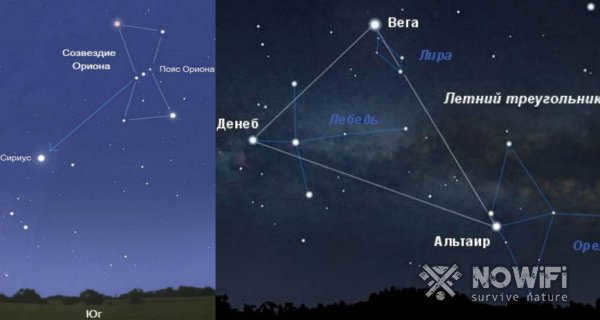
Let’s examine them in detail:
- The main misconception is that it is always directly overhead – this is not true, the name itself indicates that its position is above the North Pole, and it can only be in the center of the sky there;
- If you get lost and think it is the brightest point in the sky, you will never find your way out, as its brightness or stellar magnitude is actually quite small. You would be better off following Sirius or Vega (Figure 3) using this principle;
- The statement that the star remains fixed in the same position is only partially accurate – our planet is constantly rotating in relation to other stationary celestial objects. As the luminous point is near the pole, it appears to be almost stationary, but it actually deviates by 1 degree. In other words, you won’t see a star in Moscow where it was two days ago in St. Petersburg. As the star gets closer to the horizon, its position will constantly change based on the latitude.
Here are some additional fascinating facts:

- Unlike a compass, which points to the magnetic pole of the planet, the Northern Star helps to determine the northern direction more accurately. The magnetic pole is located away from the geographic pole and shifts by a few kilometers every year;
- As you get closer to the northern hemisphere, the Northern Star becomes a more precise tool for determining coordinates;
- In the past, the Northern Star had no connection to the pole due to the shift of the Earth’s axis. However, in about 13-14 thousand years, it will be replaced by the bright star Vega, which will make it even easier to find the northern direction;
- Despite not being one of the top 10 brightest objects in the sky, the Northern Star holds a modest 48th place in this ranking.
The Significance of Polaris in the Sky:
- Polarisissima, Cepheid, and Kinosura are just a few of the names that designate its position;
- It is situated in the constellation of Ursa Minor near the northern pole of the world;
- Throughout different periods, it has been identified as Lyra and Vega, as well as certain components of Hercules and Draco, Thuban and Cohab;
- Being one of the supergiants (Figure 4) in the spectral class, its distance from Earth is calculated to be approximately 447 light-years or 137.14 parsecs;
- It is a triple star system, with our most well-known point of orientation located at its core.
How to locate the North Star in the night sky
However, if you’re unsure of the cardinal directions, here’s how to find the North Star:

- Get two sticks, with one being slightly longer than the other;
- Place them vertically in the ground, ensuring that the taller one is slightly ahead;
- Lie down in front of them and align your sight so that a straight line is formed between your gaze and the sticks;
- Wait until one of the dots materializes before your eyes;
- Wait for a few minutes and observe its movement;
- Based on its movement – the top represents east, the bottom represents west, the left represents north, and the right represents south;
- Stand up and face towards the north;
- Identify the distinctive arrangement of seven radiant dots resembling a bucket;
- Sketch a mental line that is slightly curved and passes through the two outermost points;
- Move the 5 intervals between them upwards and observe the Cepheid (Figure 5).
Using a compass is the most popular method for locating the polar star in the sky.
How to locate the polar star with a compass:
- First, you need to set the compass’s direction and calculate the altitude of the polar star above the horizon.
- Keep in mind that the magnetic arrow on the compass may have a slight deviation due to the divergence between the geographic and magnetic poles, as well as the distortion of magnetic lines.
- This deviation is known as the magnetic declination of the area, and you can find it in any astronomical reference book or online.
- After making the necessary correction for the magnetic declination, you can determine the position of the polar star. If it is located to the west and the correction is 15 degrees, you should adjust your direction to the right of the compass arrow. If it is located to the east, adjust your direction to the left.
It is important to note that conducting such measurements in close proximity to vehicles, railroad tracks, and power lines can have an impact on the behavior of compass arrows.
An alternative approach is to utilize a ruler, which indicates the position of the polar star:
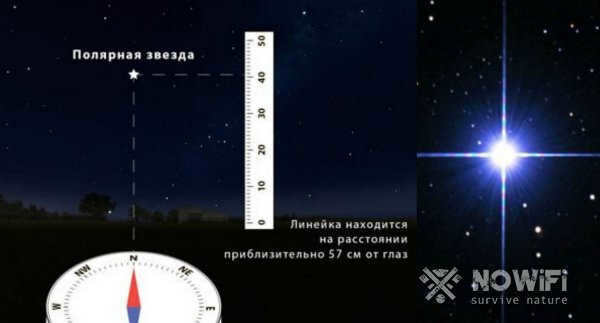
- One way to find the polaris is by measuring its angular altitude, which roughly corresponds to the latitude of your location;
- To do this, take a ruler and hold it vertically at a distance of 57cm from your eyes. Then, measure the number of degrees of elevation you have obtained and mark it off from the horizon level in centimeters upwards (Figure 6);
- The polaris itself will be visible at right angles from the lines you have marked.
Using the Big Dipper and other constellations to locate a special star
There are various methods to locate a cherished star.
Many experts recommend using the Big Dipper to find Polaris:
- First, locate the Big Dipper in the night sky;
- To the left of the Big Dipper, you will see its narrow half and tail, while to the right, you will see its wider half;
- The wider part is formed by Merak above and the more prominent Dubhe below;
- Visually draw a straight line from the lower point to the upper point;
- At a distance equal to five such straight lines, you will find the tip of the tail with Kinosura;
- Kinosura is the brightest star in that area, so it’s easy to spot.
Since most constellations are constantly moving in the sky, the Big Dipper may appear upside down or in a different position.
Since the technique is effective in favorable weather conditions, when the bear is not hidden by clouds or other obstacles, you may not always be able to employ it for searching.
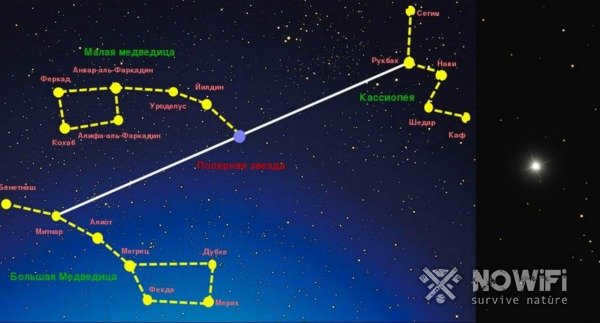
Knowing how to locate the polar star using other celestial objects can be quite helpful:
- Using the constellation Cassiopeia – it is positioned opposite to the previous constellation, with the polar star sandwiched between them. Therefore, the method for determining its position will be the same (Figure 7);
- Using the Swan constellation – draw a line from Hyena through Deneb, and mark a segment equal to two distances between these bodies from Deneb. This will help identify the approximate area where the sought-after star will be most prominent;
- Using the Orion constellation and the star Capella – draw a line from the middle element of Orion’s belt through Meissa, and mark the distance corresponding to the segment between it and Meissa from Capella. This will indicate where to search for the Cepheid star.
The final technique is specifically applicable during the winter and fall seasons when Orion can be observed above the horizon during nighttime.
Locating the North Star using technical methods
There are instances where it may be challenging to visually spot any constellations in the sky, whether due to a lack of astronomical knowledge or simply inexperience. In such cases, you can rely on technical aids, such as a camera, to assist you in your search.
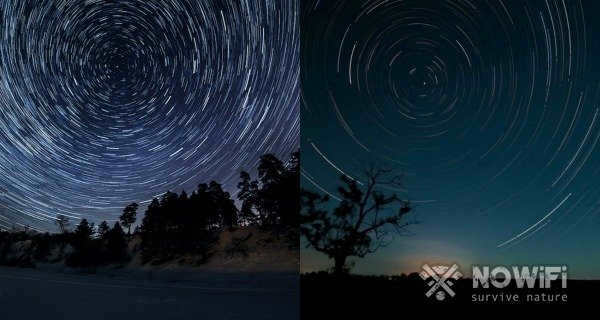
Let’s consider how to locate the polar star in the night sky using a camera:
- Any common DSLR camera will suffice for this purpose;
- All you need to do is take a photo with a fast shutter speed;
- This will capture the trails of light from moving celestial objects;
- The polar star is located near the axis of the celestial sphere and remains relatively stationary;
- The resulting photo will display concentric circles, with the smallest and shortest one indicating the position of the polar star (Figure 8);
- However, it’s not as simple as it seems – you will need to manually adjust the aperture on the camera and set the focus to infinity, while also selecting the appropriate light sensitivity of around 400-600 ISO to avoid overexposing the frame;
- You will need to manually adjust the shutter speed to 30-40 minutes in order to capture the tracks.
- When shooting at night, make sure to prevent condensation on the lens. Take your DSLR out of the bag and place it on a cold, dry surface to allow it to breathe.
- Afterwards, secure and place your device on a specialized stand to experiment with its settings.
For those who prefer a more convenient and modern approach, there are various mobile applications and their equivalents that can help determine the location of the North Star.
Smartphone apps for stargazing:
- Sky Guide for iOS and Stellarium for Android are highly recommended.
- These apps utilize your smartphone camera to identify constellations.
- They also calculate the position of the constellations based on your specified location, time of year, and day.
- Even though they may improve the performance of your smartphone’s camera, if the camera itself is not strong enough, you will not be able to capture polarissima.
Engaging in an active holiday is essential for any adventurous traveler. It’s not enough to rely solely on maps and compasses; being able to navigate by the sun, clock, and stars is a must. Humans have been using the stars for orientation since ancient times, and the best part is, it doesn’t require any special equipment. While it’s true that you can try to find the north by observing moss on trees or ant hills, these methods are not always accurate enough. Making even a small mistake in orientation can result in significant deviations from your intended route. To accurately determine the north, it’s best to use a clock with an arrow or, during nighttime, rely on the stars. And to do that, you need to locate Polaris in the sky. Let’s explore why Polaris is crucial and how to find it.
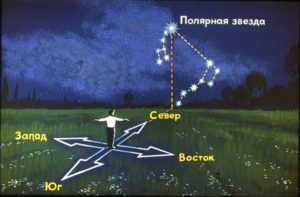
What is Polaris and why is it important for navigation?
Polaris is a star located in the constellation of Ursa Minor. Despite common misconceptions, it is not the brightest star in the sky, so relying solely on this fact may lead to incorrect identification. In terms of brightness, Polaris ranks among the fifty brightest stars visible in the night sky.
It is common knowledge that the Earth revolves around its axis, so many people believe that the sky and its stars rotate at night, changing their positions. If you observe closely, you will notice that they do indeed rotate, but only around a single axis known as the axis of the world. This is where you can find the star you are searching for. Unlike the others, it remains relatively stationary, only deviating by 1°. One could consider Polaris as a stable island in a constantly changing world, as it always points north. To determine the northern direction, all you need to do is locate Polaris and draw an imaginary line perpendicular to the horizon. The point where these lines intersect will be the north.
Initially, the task seems straightforward. You locate and draw an imaginary line that is perpendicular to the ground. Nevertheless, in reality, the search becomes much more difficult due to the fact that the surrounding constellations constantly shift their positions, depending on the observer’s location, the season, and the time of day.
Methods for locating Polaris
Through the Stars
The night sky is filled with countless stars, and they are especially visible and spectacular when you go hiking. In the city, however, the number of visible stars is significantly reduced. Some stars shine with a much greater intensity than others. When stars are situated close to each other, they can form recognizable patterns and shapes. These constellations stand out prominently among the smaller celestial bodies.
Among all the constellations, the Big Dipper is perhaps the most easily recognizable. By following the shape of the Big Dipper, one can easily locate the North Star, Polaris, which stands out from the rest. The Big Dipper resembles a large ladle with a handle, tilted to the left, and consists of seven bright stars. In reality, there are many more stars in this constellation, but they are not visible to the naked eye.
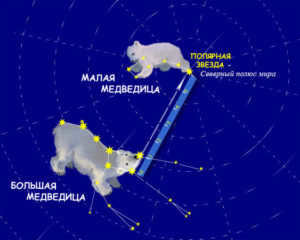
If you observe closely, you can spot the Ursa Minor (also referred to as the Little Dipper, which is a smaller version of the Big Dipper with a handle facing downwards). Polaris is situated at the end of the handle of the Ursa Minor. To determine the north direction from this celestial body, it is necessary to mentally draw a perpendicular line to the Earth’s surface.
There are instances when the constellation Ursa Major is obscured by clouds, making it challenging to locate the Ursa Minor. In such cases, the constellation Cassiopeia is utilized. It bears a resemblance to a coiled snake or a large letter “M”. It consists of five luminaries that are clearly visible. By drawing an imaginary line from the attachment point of the handle of the Big Dipper to the first left point on the “M”, Polaris will be approximately positioned at the center of this line.

Using a camera
When going on a hike, there are a few essential items that you should always bring with you – a compass, map, watch, and of course, your camera. Your camera can come in handy for more than just capturing beautiful scenery; it can also help you find the polar star. It’s even better if your camera has a shutter speed function, especially if it’s a professional camera. By taking pictures of the starry sky with a fast shutter speed, you can capture the stars with long tails – these tails are actually traces of their movement. Since Polaris is located on the axis, it doesn’t move much, and therefore, it won’t have a tail. As a result, in the photo, it will appear as if there are many stars leaving a trail and moving in orbit around Polaris.
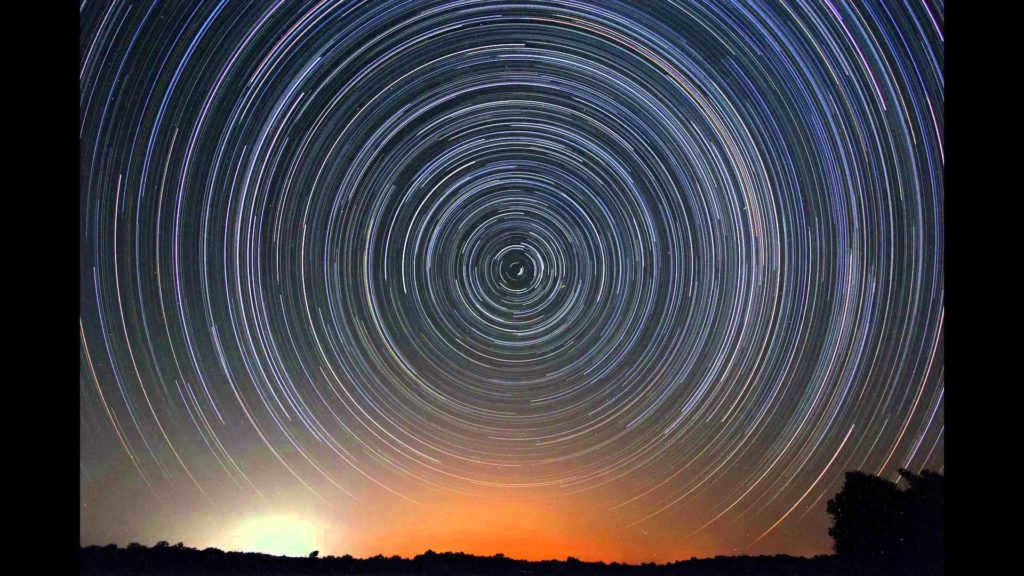

It is worth noting that the Earth’s axis is in a constant state of movement. In just 13,000 years, Polaris will no longer be the guiding star, and Vega will take its place. Therefore, if you happen to be reading this article in 13,000 years, please be aware that the information provided here may be outdated.
During the night, all you need to do is look up to see countless shining specks in the sky. Among them, there are a few celestial bodies that hold great importance for humans. By using these stars as a guide, you can determine your exact location, find your way back home, and gain a sense of direction in relation to the cardinal points. In order to achieve this, it is essential to know how to locate Polaris in the vast expanse of the starry sky.

Details about the celestial body
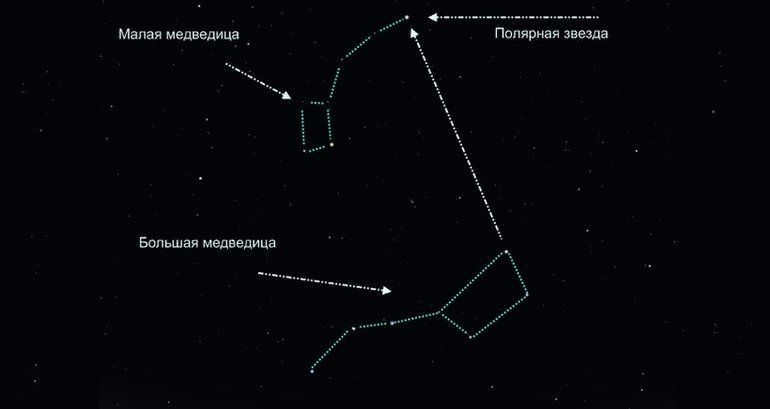
Polaris (also known as the North Star and Kinosura) is an immense celestial object situated hundreds of light years away from our planet. Due to its distance, it appears relatively faint in the night sky, making it challenging for observers to locate.
Polaris resides within the Little Bear constellation, near the North Pole. It is a trinary star system, featuring a supergiant star at its core. Astronomers have noted the following noteworthy characteristics of Polaris:
- Ranks as the 48th brightest celestial object in the sky;
- Located approximately 447 light-years away from Earth;
- Has a size 50 times that of the Sun and a mass 6.5 times greater;
- Estimated age of around 60 million years.

Polaris was first identified many centuries ago,but back then it wasn’t recognized as the pole star. Around 14,000 years ago, Vega in the constellation Lyra held that distinction. However, due to the constant movement of celestial bodies and the shifting of the Earth’s axis, Polaris gradually assumed its current position.
The massive star in the Little Bear constellation is still moving, and in a few centuries, it will no longer be aligned with the North Pole of the planet. By the year 3200, Kinosura will be replaced by the star Alrai in the Cepheus constellation. Approximately 25,000 years later, the cycle of movement that started in 1110 AD will be completed, resulting in the reappearance of Polaris at the zenith.
Many individuals have only had a surface-level education in astronomy during their time in school. As a result, not everyone is familiar with how to locate Polaris in the celestial sphere. However, there are several accessible methods that can be used to accomplish this without the need for special equipment.
Using the Big and Little Dipper
The most straightforward approach to finding Polaris in the night sky involves identifying the neighboring constellation, the Big Dipper. Understanding the correct sequence of steps will help clarify why this is necessary. The process can be broken down as follows:

- Thoroughly examine the star clusters and search for a shape resembling a big container with a long handle. The right side of this “container” will be slightly narrower than the left.
- Mentally connect the two rightmost points (Dubhe and Merak) with a line.
- Increase the resulting segment by 5 times and combine it with the existing one.
- The end of the longer line will indicate the edge of the handle of another dipper – the Little Dipper.
- It is at this location that Polaris will be situated.
Using a City Map to Determine the Position of Alpha of the Little Bear
To find the location of Alpha of the Little Bear relative to the horizon, it is necessary to have a city map. These maps can be easily obtained from any newsstand at a reasonable price.
It is essential that the map includes a scale and the names of major landmarks.
Here is the step-by-step process:
- First, consult reference materials to determine the height of Polaris above the horizon. This value depends on the time of year and the latitude of the city.
- Select a prominent feature, such as a road or large building, and locate it on the city map.
- Next, align the map with the chosen position on the ground.
- Identify the object (building, body of water, plaza, TV tower, etc.) that is located at the center of the top portion of the map.
- Shift your focus to that object and visualize moving upward.
- Once you reach a specific height, locate the Alpha of the Little Bear, which appears as a faint star.
Unfamiliar with the cardinal directions
Many times individuals find themselves disoriented and unsure of which way to go. In such situations, it is important to raise one’s gaze and observe the position of the stars. The celestial objects in the night sky can guide one in determining the cardinal directions and ultimately find their way back home.
Actions taken by humans:

- Grab two sticks, with one of them slightly longer than the other.
- Insert the sticks into the ground, ensuring that the longer one is positioned slightly ahead.
- Lie down and align yourself in a straight line with the stick and your gaze.
- Once a celestial object appears in front of your gaze, observe its movement for a few minutes.
- To determine the north direction, look to the left of the object’s path.
- Now, stand up and search for a constellation in the north that resembles a small bucket and is made up of several stars.
- Mentally trace a curved line connecting the two rightmost stars.
- Next, draw five similar segments upwards and locate the desired object.
Discovering Kinosura with a Ruler
Kinosura, a star in the Little Bear constellation, can easily be located using a common school tool – a ruler. All it takes is a few simple steps. Here are some of the actions you should take:
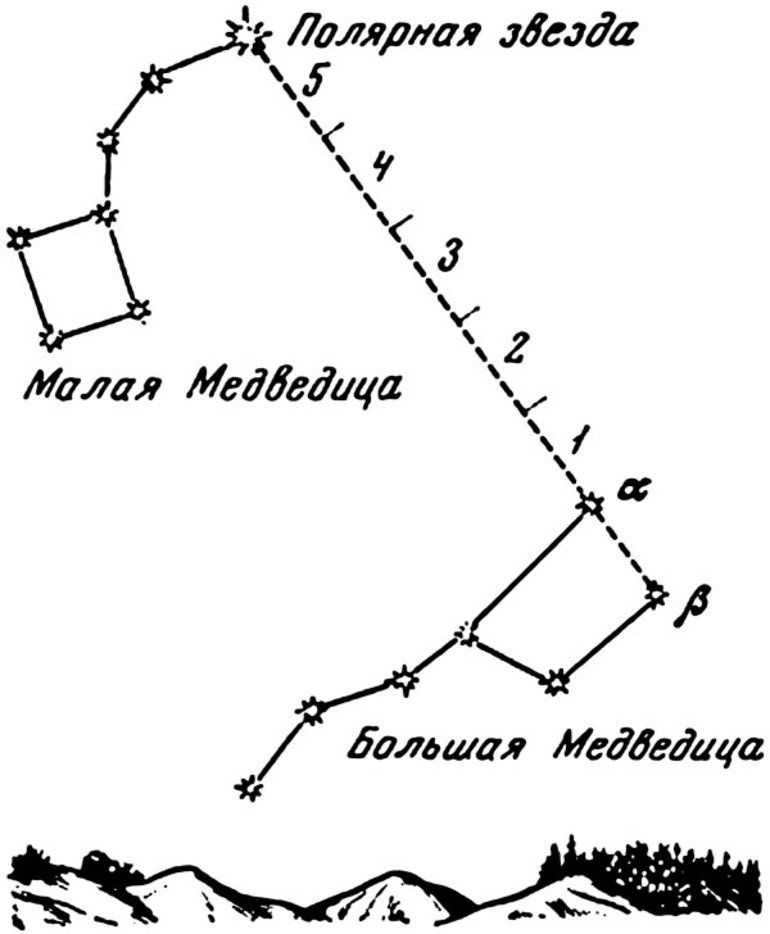
- Find out the latitude of the area where you are searching for the polar star.
- Next, determine the direction of north using any available method.
- Then, take a ruler and hold it at a distance of 57 cm from your eyes.
- Align the zero mark on the ruler with the horizon line.
- Measure 40.5 centimeters upwards. If you’ve followed the steps correctly, you should be able to see the Alpha star of the Ursa Minor constellation at this point.
Determining by Various Constellations
Locating the correct star in the night sky can be accomplished by observing the positions of different constellations. These groupings of stars are readily identifiable, making the task suitable for beginners as well.
Methods for Identifying Stars via Different Constellations:
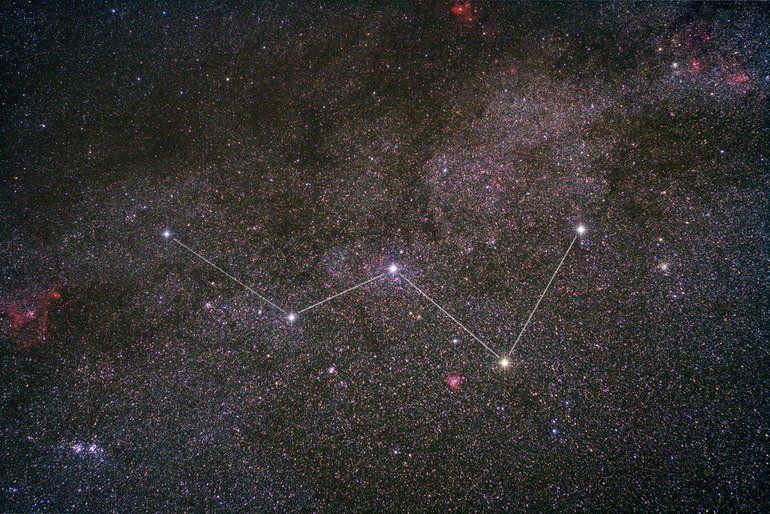

- To locate Kinosura, it is important to first locate the brightest star in the constellation of Cassiopeia, which is Rukbach. Additionally, one must determine the position of Mitnar in the Big Dipper constellation. These celestial objects are linked by an imaginary line that will pass through Polaris, with the star being situated in the middle of this line segment.
- To find the exact position of Kinosura, one must draw a line passing through Epsilon of the Swan (also known as Jenach) and Deneb. Along this line, a distance equal to twice the length between these two objects should be measured. By doing so, the endpoint of this line will indicate the specific region of the sky where Polaris, the brightest star, can be found.
- To find the desired star in the constellation of Orion, start by visualizing a line from Alnilam (the middle star of Orion’s belt) to Meissa (a celestial object in the upper part of the constellation). Remember the length of this line and extend it from Capella, the brightest star in the constellation of Ascendant. At the end of this line, you will be able to locate the object you are searching for.
If you possess a compass
If you happen to be in possession of a compass, locating Kinosura will be a breeze. With the assistance of this navigational tool, one can easily determine the correct path to follow, leading them out of the forest. It is important to note that the north can be identified by Polaris, commonly known as the North Star, while the south can be ascertained by turning 180 degrees. To travel east, simply move towards the right, and to venture west, proceed towards the left.
Step-by-step guidelines:
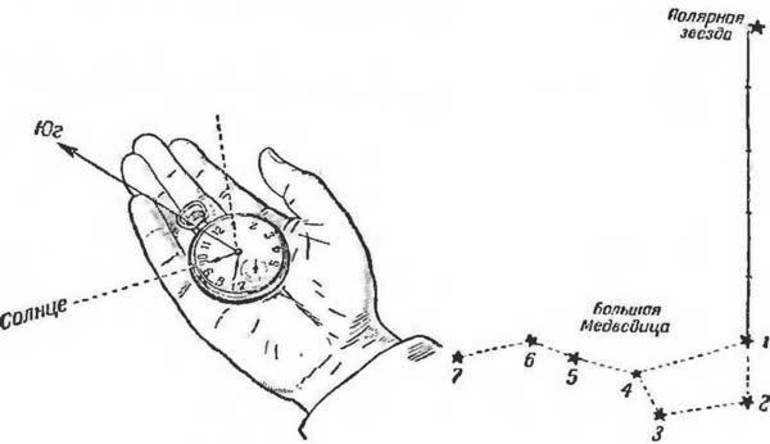
- Using a compass, establish the direction of the north. It is important to carry out this task in an area that is free from railway tracks, power lines, and vehicles, as these can interfere with the accuracy of the readings.
- Adjustments need to be made to the collected data in order to account for the deviation between the magnetic and geographic poles.
- Once the northern direction has been accurately determined, you can proceed with locating Polaris. There are various methods that can be employed for this purpose.
Detecting Kinosura can be accomplished using various modern devices. This method does not require any knowledge in the field of astronomy, making it accessible to anyone who is interested.
Camera and Telescope
In today’s world, there are numerous telescopes available that can automatically adjust to the desired object. All a person needs to do is set the basic parameters and enjoy the outcome. However, these complex and expensive devices are not suitable for everyone. As a result, amateur astronomers suggest using a regular SLR camera instead. With this camera, you can easily locate Polaris by following these steps:
- Secure the camera onto a tripod and aim it at the night sky. The weather should be clear and there should be minimal artificial light.
- The mirror camera is designed to allow for capturing images with a lengthy exposure time, typically lasting at least 2 hours. It is crucial to keep in mind the limited battery life, as it could potentially run out and disrupt the entire process.
- After the process is complete, a finalized image will be produced, displaying the trails of all the stars in motion. The only object that will not exhibit circular motion is Polaris. In the image, it will appear as a singular point surrounded by concentric circles.
A smartphone application
A significant portion of the population has already made the transition to modern smartphones, which offer the ability to download a variety of useful applications. Among the numerous available programs, there are several dedicated to astronomy. These applications allow users to easily locate and identify any star in the sky, access information about it, and even track its trajectory. Stellarium is one of the most popular apps for Android, while Sky Guide is widely used by iOS users.
The process of utilizing these applications:
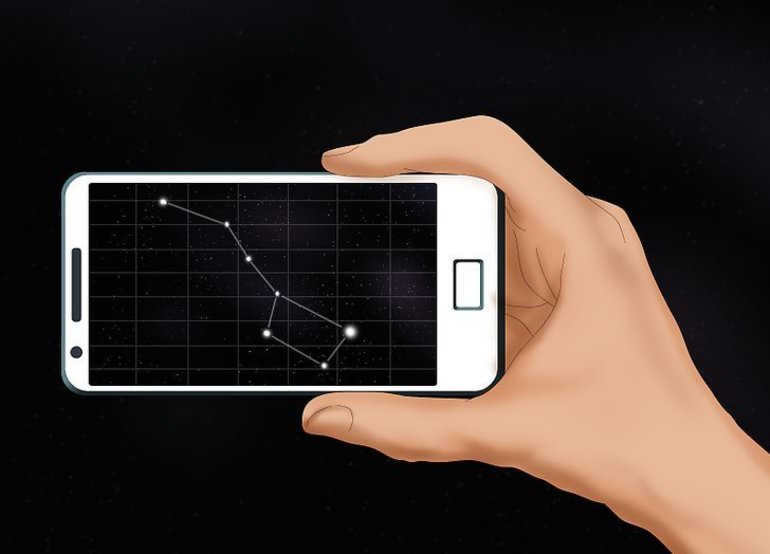
- Once the installation is complete, the program will be activated.
- Aim your smartphone camera towards the night sky full of stars.
- All the celestial objects that come into the camera’s view will be displayed on the screen as a map.
- To locate Kinosura, direct your camera towards the constellations of Ursa Minor and Ursa Major.
- In the resulting image, search for the star positioned at the end of the handle of the smaller dipper.
- To access detailed information about the star, simply click on its name.
- You have the ability to track its movement by adjusting the date and time settings.
Possible errors
When searching for Polaris, newcomers frequently make errors that prevent successful completion of the process. In most cases, these issues arise due to insufficient knowledge and understanding of astronomy.
Possible mistakes:
- Many novice astronomers mistakenly believe that Polaris is always directly overhead. As a result, they spend hours searching the night sky but are unable to locate the correct star. This confusion arises because Polaris can only be seen at the zenith from the North Pole. In all other regions, it will be offset from the zenith by a significant distance.
- Some travelers tend to overlook the fact that the Earth rotates, causing them to mistakenly believe that the stars remain fixed in the sky. As a result, they inadvertently choose a different celestial object as their reference point each time.
- When in the southern hemisphere, it is highly uncommon to spot Polaris. The only opportunity arises due to the refraction of light, which causes the star to appear near the horizon line. Unfortunately, not everyone is aware of this particularity, leading them to select the wrong star as their reference point while in Australia, Africa, or South America.





